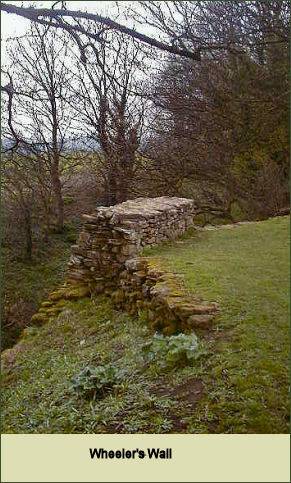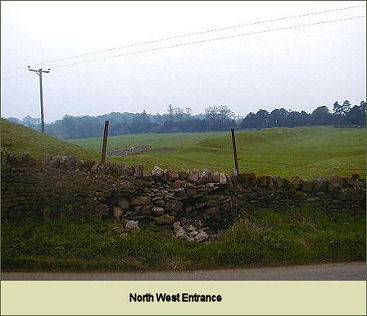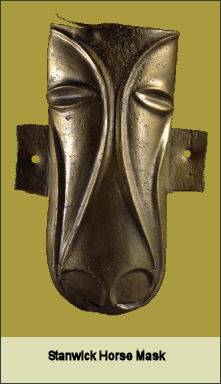Stanwick Iron Age Fort
OS grid reference:- NZ 183 124
 A complex of earthworks mark the remains of the first century AD Stanwick Iron Age Fort, defensive fortifications of the Celtic Brigantes tribe of Notrth Yorkshire. It features over 9 kilometers (5.6 miles) of ditches and ramparts enclosing around 300 hectares (700 acres) of land.
A complex of earthworks mark the remains of the first century AD Stanwick Iron Age Fort, defensive fortifications of the Celtic Brigantes tribe of Notrth Yorkshire. It features over 9 kilometers (5.6 miles) of ditches and ramparts enclosing around 300 hectares (700 acres) of land.
 The fortifications are situated some 8 miles (13 km) north of the town of Richmond and 10 miles (16 km) south west of Darlington, near to Scotch Corner and the remains of the Roman fort and bridge at Piercebridge.
The fortifications are situated some 8 miles (13 km) north of the town of Richmond and 10 miles (16 km) south west of Darlington, near to Scotch Corner and the remains of the Roman fort and bridge at Piercebridge.
Evidence exists to define the fortifications as being contemporary with the Late Iron Age and start of the Roman presence in Britain, the fort may have lost its importance around 70AD with the increasing Roman conquest of the area.
Sir Mortimer Wheeler led a team of archaeologists excavating the fort in the summers of 1951 and 1952. Wheeler 's 1954 account of the history and excavation of the ramparts stated it to be an important centre of the Brigantes, he considered it to be the rebel stronghold of the Brigantian Venutius, the ex-partner of the Queen Cartimandua.
The Brigantes were the most powerful tribe in northern Britain in the early Roman period, the warlike Brigantes occupied the largest section of what would later become Northern England, and a significant part of the Midlands. Their name derives from the Celtic goddess Brigantia.Territorially the largest tribe in Britain, their kingdom, centred in what later became Yorkshire, is referred to as Brigantia.
For a time they were strong enough to withstand Romans advancing from the south. After the finally being defeated by the Romans, the Brigantes moved their capital to Aldborough, or Isurium as it was known to the Romans.
The Stanwick fortifications were enlarged and fortified on the arrival of the Romans in Britain in the first century AD. Dividing them into three phases, the earliest Phase I area (Iron Age) was reported to cover 17 acres. Phase II was extended over 130 acres; and Phase 3 further extended the enclosure over another 600 acres. A further extension of earthworks appears to have occurred, but Wheeler thought them to have been constructed at a much later era.
 Archaeologists who carried out further work on the site in the 1980s for Durham University and led by Percival Turnbull and Professor Colin Haselgrove, found an adult male burial at the rear of a rampart in the fortifications where a horse's head had been carefully placed upon the body. Turnbull and Haselgrove later concluded that it was one of Cartimandua's "estates" and possibly even the original capital city of Brigantia. The site was not purely defensive, but was used as a trading centre and administrative capital for the Brigantes.
Archaeologists who carried out further work on the site in the 1980s for Durham University and led by Percival Turnbull and Professor Colin Haselgrove, found an adult male burial at the rear of a rampart in the fortifications where a horse's head had been carefully placed upon the body. Turnbull and Haselgrove later concluded that it was one of Cartimandua's "estates" and possibly even the original capital city of Brigantia. The site was not purely defensive, but was used as a trading centre and administrative capital for the Brigantes.
Numerous finds from the site include pottery , an Iron Age sword, still in its well-preserved ash wood scabbard, a human skull revealing considerable damage from wounds inflicted by an axe or a sword, and miscellaneous objects of wood, metal, bone, and basketwork.
The thirteenth century church of St John's stands within the earthworks of the fort, it features a ninth century Saxon cross shaft and other Saxon remains.
In 1845 a hoard of 140 metal artefacts was discovered. It is known as the Stanwick Hoard and included four sets of horse harness for chariots and a bronze horse head mask, were found half a mile away at the village of Melsonby. These are now displayed at the British Museum. The mask is a small bronze model of a horse's head, it is not solid, but constructed from a thin sheet of bronze and was made to be nailed or riveted to a wooden object.
The Stanwick site is now in the care of English Heritage.
Directions
From Scotch Corner on the A1 road, take the A66 and then the first right through the village of Melsonby at the crossroads. Continue for a few more miles until arriving at Stanwick-St.-John.
Prehistoric and Roman Sites of Yorkshire
Historic Buildings of Yorkshire
External Links
Cartimandua, Queen of the Brigantes
